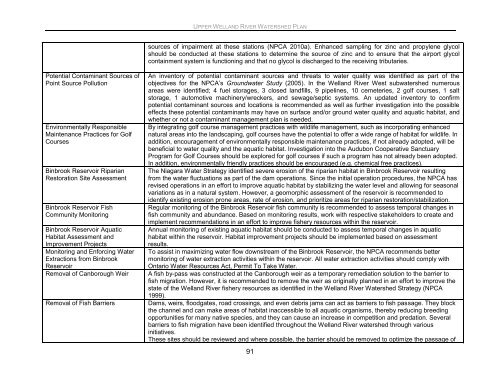Upper Welland River Watershed Plan - Niagara Peninsula ...
Upper Welland River Watershed Plan - Niagara Peninsula ...
Upper Welland River Watershed Plan - Niagara Peninsula ...
You also want an ePaper? Increase the reach of your titles
YUMPU automatically turns print PDFs into web optimized ePapers that Google loves.
UPPER WELLAND RIVER WATERSHED PLANsources of impairment at these stations (NPCA 2010a). Enhanced sampling for zinc and propylene glycolshould be conducted at these stations to determine the source of zinc and to ensure that the airport glycolcontainment system is functioning and that no glycol is discharged to the receiving tributaries.Potential Contaminant Sources ofPoint Source PollutionEnvironmentally ResponsibleMaintenance Practices for GolfCoursesBinbrook Reservoir RiparianRestoration Site AssessmentBinbrook Reservoir FishCommunity MonitoringBinbrook Reservoir AquaticHabitat Assessment andImprovement ProjectsMonitoring and Enforcing WaterExtractions from BinbrookReservoirRemoval of Canborough WeirRemoval of Fish BarriersAn inventory of potential contaminant sources and threats to water quality was identified as part of theobjectives for the NPCA‟s Groundwater Study (2005). In the <strong>Welland</strong> <strong>River</strong> West subwatershed numerousareas were identified; 4 fuel storages, 3 closed landfills, 9 pipelines, 10 cemeteries, 2 golf courses, 1 saltstorage, 1 automotive machinery/wreckers, and sewage/septic systems. An updated inventory to confirmpotential contaminant sources and locations is recommended as well as further investigation into the possibleeffects these potential contaminants may have on surface and/or ground water quality and aquatic habitat, andwhether or not a contaminant management plan is needed.By integrating golf course management practices with wildlife management, such as incorporating enhancednatural areas into the landscaping, golf courses have the potential to offer a wide range of habitat for wildlife. Inaddition, encouragement of environmentally responsible maintenance practices, if not already adopted, will bebeneficial to water quality and the aquatic habitat. Investigation into the Audubon Cooperative SanctuaryProgram for Golf Courses should be explored for golf courses if such a program has not already been adopted.In addition, environmentally friendly practices should be encouraged (e.g. chemical free practices).The <strong>Niagara</strong> Water Strategy identified severe erosion of the riparian habitat in Binbrook Reservoir resultingfrom the water fluctuations as part of the dam operations. Since the initial operation procedures, the NPCA hasrevised operations in an effort to improve aquatic habitat by stabilizing the water level and allowing for seasonalvariations as in a natural system. However, a geomorphic assessment of the reservoir is recommended toidentify existing erosion prone areas, rate of erosion, and prioritize areas for riparian restoration/stabilization.Regular monitoring of the Binbrook Reservoir fish community is recommended to assess temporal changes infish community and abundance. Based on monitoring results, work with respective stakeholders to create andimplement recommendations in an effort to improve fishery resources within the reservoir.Annual monitoring of existing aquatic habitat should be conducted to assess temporal changes in aquatichabitat within the reservoir. Habitat improvement projects should be implemented based on assessmentresults.To assist in maximizing water flow downstream of the Binbrook Reservoir, the NPCA recommends bettermonitoring of water extraction activities within the reservoir. All water extraction activities should comply withOntario Water Resources Act, Permit To Take Water.A fish by-pass was constructed at the Canborough weir as a temporary remediation solution to the barrier tofish migration. However, it is recommended to remove the weir as originally planned in an effort to improve thestate of the <strong>Welland</strong> <strong>River</strong> fishery resources as identified in the <strong>Welland</strong> <strong>River</strong> <strong>Watershed</strong> Strategy (NPCA1999).Dams, weirs, floodgates, road crossings, and even debris jams can act as barriers to fish passage. They blockthe channel and can make areas of habitat inaccessible to all aquatic organisms, thereby reducing breedingopportunities for many native species, and they can cause an increase in competition and predation. Severalbarriers to fish migration have been identified throughout the <strong>Welland</strong> <strong>River</strong> watershed through variousinitiatives.These sites should be reviewed and where possible, the barrier should be removed to optimize the passage of91
















